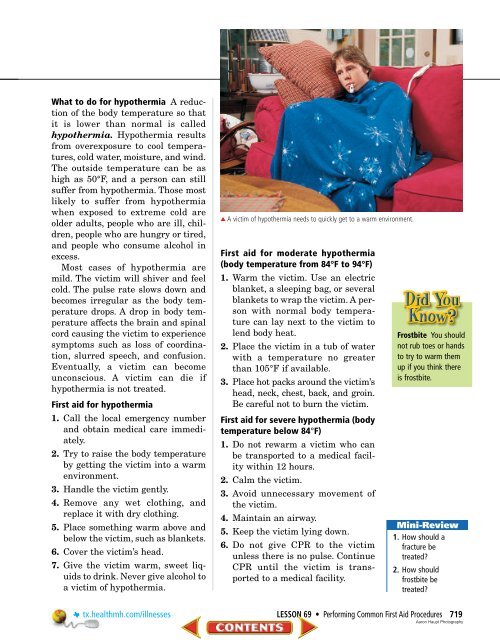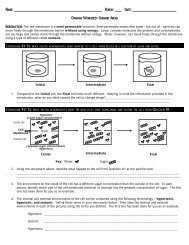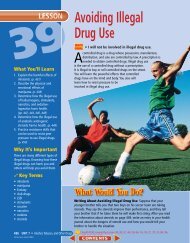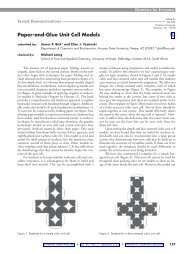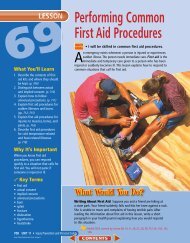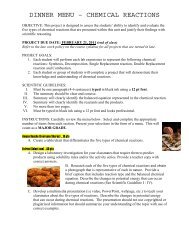Lesson 69 Performing Common First Aid Procedures
Lesson 69 Performing Common First Aid Procedures
Lesson 69 Performing Common First Aid Procedures
Create successful ePaper yourself
Turn your PDF publications into a flip-book with our unique Google optimized e-Paper software.
What to do for hypothermia A reduction<br />
of the body temperature so that<br />
it is lower than normal is called<br />
hypothermia. Hypothermia results<br />
from overexposure to cool temperatures,<br />
cold water, moisture, and wind.<br />
The outside temperature can be as<br />
high as 50°F, and a person can still<br />
suffer from hypothermia. Those most<br />
likely to suffer from hypothermia<br />
when exposed to extreme cold are<br />
older adults, people who are ill, children,<br />
people who are hungry or tired,<br />
and people who consume alcohol in<br />
excess.<br />
Most cases of hypothermia are<br />
mild. The victim will shiver and feel<br />
cold. The pulse rate slows down and<br />
becomes irregular as the body temperature<br />
drops. A drop in body temperature<br />
affects the brain and spinal<br />
cord causing the victim to experience<br />
symptoms such as loss of coordination,<br />
slurred speech, and confusion.<br />
Eventually, a victim can become<br />
unconscious. A victim can die if<br />
hypothermia is not treated.<br />
<strong>First</strong> aid for hypothermia<br />
1. Call the local emergency number<br />
and obtain medical care immediately.<br />
2. Try to raise the body temperature<br />
by getting the victim into a warm<br />
environment.<br />
3. Handle the victim gently.<br />
4. Remove any wet clothing, and<br />
replace it with dry clothing.<br />
5. Place something warm above and<br />
below the victim, such as blankets.<br />
6. Cover the victim’s head.<br />
7. Give the victim warm, sweet liquids<br />
to drink. Never give alcohol to<br />
a victim of hypothermia.<br />
tx.healthmh.com/illnesses<br />
A victim of hypothermia needs to quickly get to a warm environment.<br />
<strong>First</strong> aid for moderate hypothermia<br />
(body temperature from 84°F to 94°F)<br />
1. Warm the victim. Use an electric<br />
blanket, a sleeping bag, or several<br />
blankets to wrap the victim. A person<br />
with normal body temperature<br />
can lay next to the victim to<br />
lend body heat.<br />
2. Place the victim in a tub of water<br />
with a temperature no greater<br />
than 105°F if available.<br />
3. Place hot packs around the victim’s<br />
head, neck, chest, back, and groin.<br />
Be careful not to burn the victim.<br />
<strong>First</strong> aid for severe hypothermia (body<br />
temperature below 84°F)<br />
1. Do not rewarm a victim who can<br />
be transported to a medical facility<br />
within 12 hours.<br />
2. Calm the victim.<br />
3. Avoid unnecessary movement of<br />
the victim.<br />
4. Maintain an airway.<br />
5. Keep the victim lying down.<br />
6. Do not give CPR to the victim<br />
unless there is no pulse. Continue<br />
CPR until the victim is transported<br />
to a medical facility.<br />
Frostbite You should<br />
not rub toes or hands<br />
to try to warm them<br />
up if you think there<br />
is frostbite.<br />
Mini-Review<br />
1. How should a<br />
fracture be<br />
treated?<br />
2. How should<br />
frostbite be<br />
treated?<br />
LESSON <strong>69</strong> • <strong>Performing</strong> <strong>Common</strong> <strong>First</strong> <strong>Aid</strong> <strong>Procedures</strong> 719<br />
Aaron Haupt Photography


